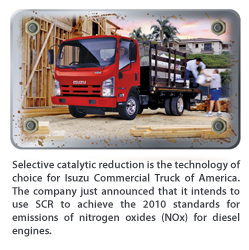Isuzu to Use scr Technology to Meet Emissions Requirements

Isuzu Commercial Truck of America just announced that it intends to use selective catalytic reduction (SCR) to achieve the 2010 standards for emissions of nitrogen oxides (NOx) of diesel engines. SCR is an after-treatment technology that involves injecting a water-based solution containing urea into the hot exhaust stream of an engine. This diesel exhaust fluid (DEF), working with a catalyst in the exhaust after-treatment system, breaks down the NOx into harmless nitrogen and water vapor. DEF contains an organic nitrogen compound used as a fertilizer in agriculture. It is classified as a non-hazardous substance by the Environmental Protection Agency.
“Isuzu has been developing after-treatment technology in Japan for many years,” said Shaun Skinner, executive vice president and general manager at Isuzu. “We’ve studied different systems and found SCR to be highly reliable under even the most extreme applications and conditions.”
Of course, Isuzu uses both technologies. The company intends to continue to use both a diesel particulate filter (DPF) and exhaust gas recirculation (EGR), which it introduced in its trucks in 2007. The new technology will be used in Isuzu engines sold in its trucks in the United States under the Isuzu, Chevrolet and GMC trademarks. Cooled exhaust gas recirculation technologies lower an engine’s peak combustion temperature to lower NOx output.
Isuzu low cab forward trucks are distributed through 205 Isuzu truck dealers and 350 GM W-Series dealers nationwide. Isuzu trucks have been the best-selling low cab forward brand in the United States every year since 1986. Of the 400,000 Isuzu-built diesel trucks sold in North America since 1984, more than 83 percent are still registered and in service, say company officials.

Comments are closed here.